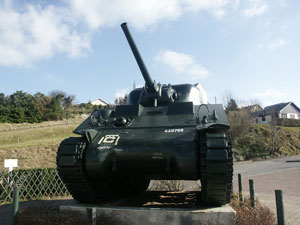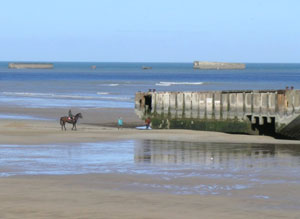The Funnies concept
Arromanches

Port Winston
Arromanches was the site of the British Mulberry (Mulberry B), and today its remains dominate the seascape of this small port.
The artificial ports were the brainchild of Winston Churchill, who said he conceived the idea in 1917. Twenty-seven years later, two were actually constructed: Mulberry A at Omaha Beach (rendered unusable by the storm of 19-21 June) and Mulberry B at Arromanches. They were composed of several elements floating breakwaters (Bombardon) forming an outer protective circle, concrete caissons (Phoenix) and derelict ships sunk to form the perimeter of the harbor, pierheads which could rise and fall with the tide, and floating metal piers connecting the pierheads to the shore. All elements were constructed in England and towed across the Channel beginning on D-Day plus 1. Some 500,000 tons of supplies had been off-loaded through Mulberry B by the end of August. Whether or not the Mulberries were essential links in the supply chain is debatable, but as Chester Wilmot pointed out, the fact that they were to be built gave Neptune planners the assurance that, failing all else, forces ashore could be adequately supplied. That assurance was worth a great deal in early 1944. From the museum, it is possible to drive to the top of the bluffs east of town, where there is a Sherman tank, and a short distance further is a German radar station, next to an overlook platform that provides an excellent view of the port and the remains of Mulberry B. The visible bunkers from the cliff top were silenced by fire from HMS Belfast, which is now at rest in the Thames in London.

Mulberries
Each Mulberry harbor consisted of roughly 6 miles of flexible steel piers (Whales) that floated on steel or concrete floats (called Beetles). The pier end was great pier head, called Spuds pontoon that were jacked up and down along long legs which rested on the seabed. These structures were to be sheltered from the sea by lines of massive sunken caissons (called Phoenixes), lines of scuttled ships (called Gooseberries), and a line of floating breakwaters (called Bombardons). It was estimated that construction of the caissons alone required 330,000 cubic yards of concrete, 31,000 tons of steel, and 1.5 million yards of steel shuttering.
OREP
15 Rue de Largerie
14480 Cully
Tel: 02 31 08 31 08
info@orep-pub.com